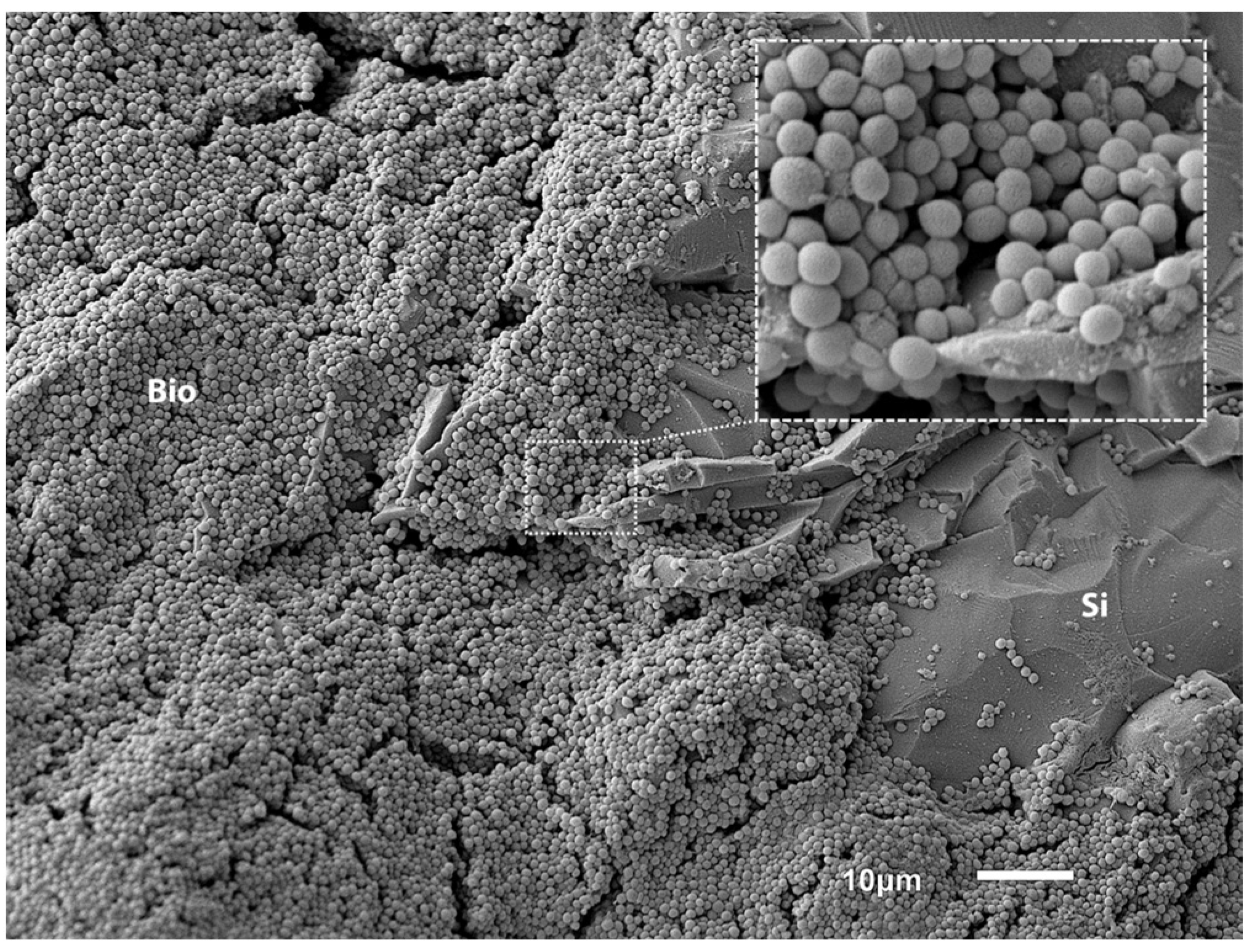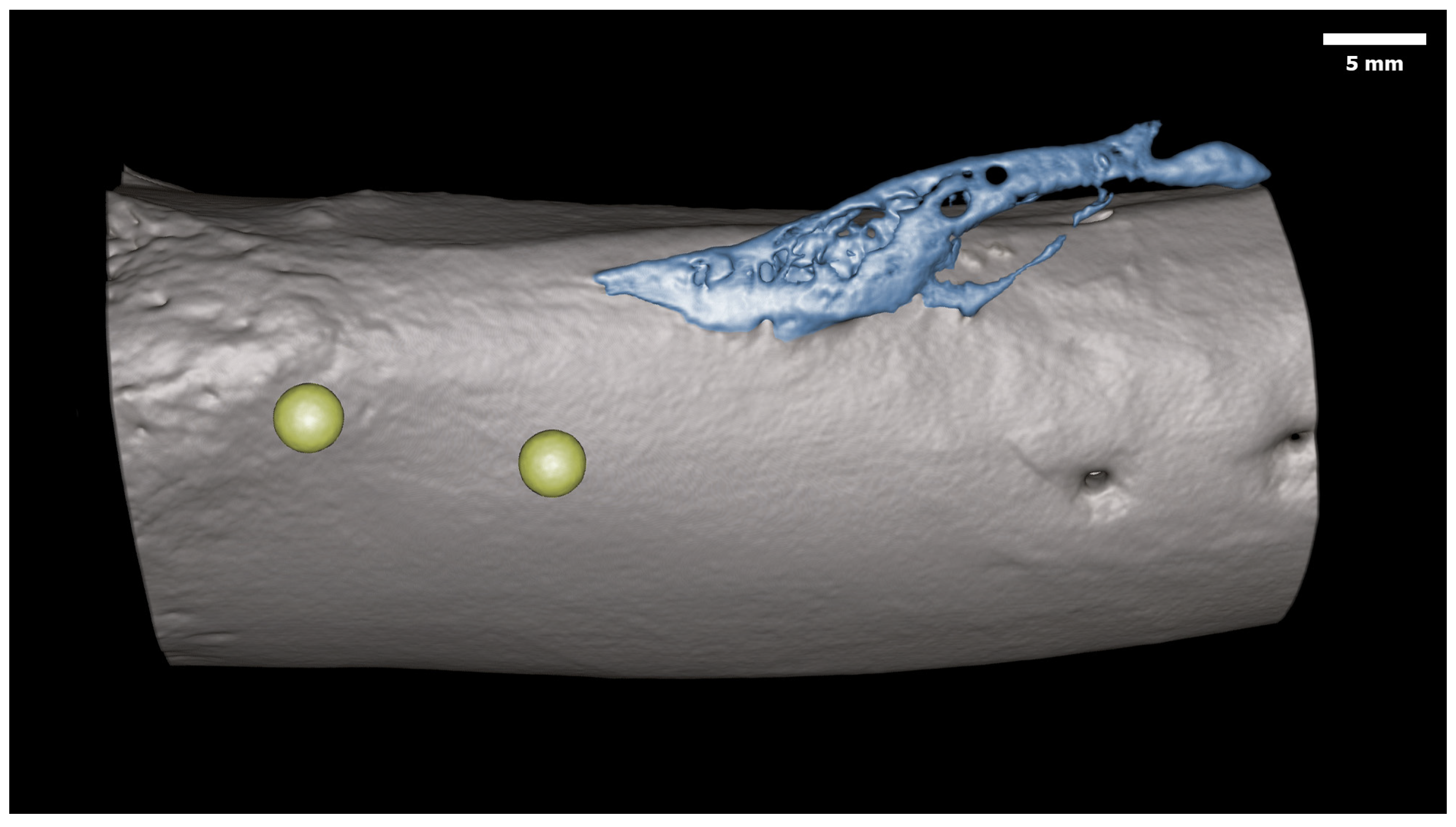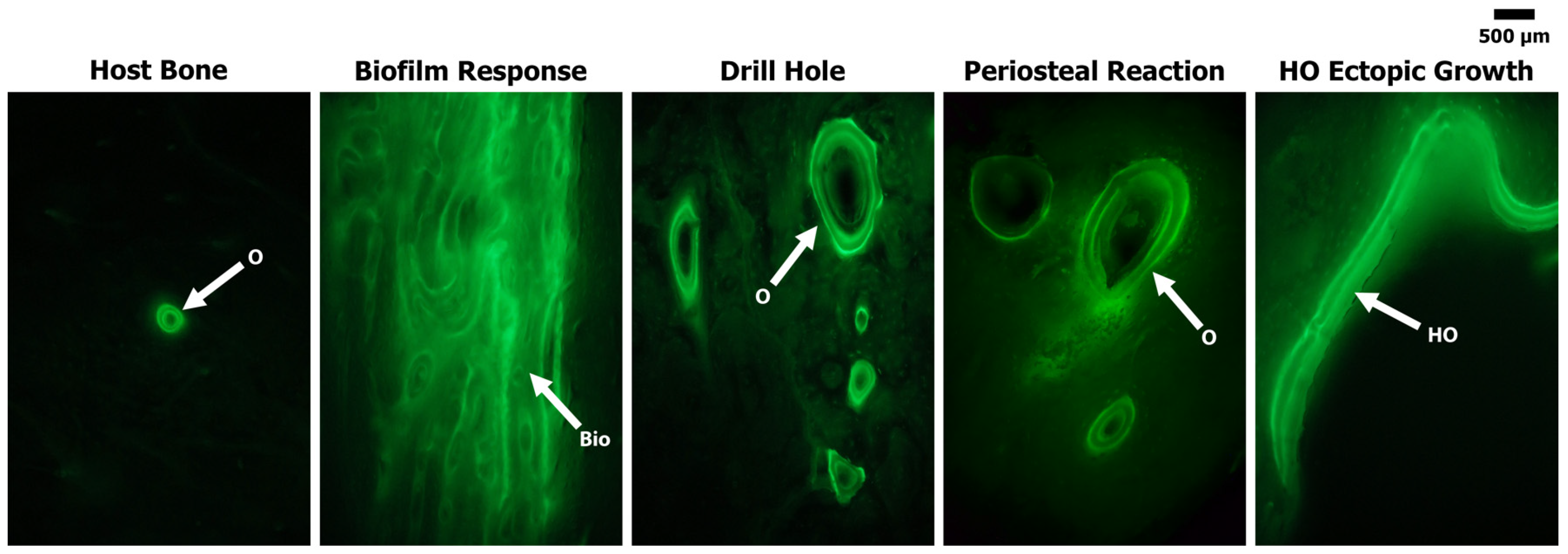Determining Which Combinatorial Combat-Relevant Factors Contribute to Heterotopic Ossification Formation in an Ovine Model
Abstract
1. Introduction
2. Materials and Methods
2.1. Supplies, Instruments, and Reagents
2.2. Air Impact Device
2.3. Biofilm Growth
2.4. Animal Model and Trauma Factors
- AID: The AID was positioned above the incision site, pressurized to 100 PSI, and discharged. This was repeated five times. Fluoroscopic images were captured to confirm the AID blast did not cause bone fracture, as required by the IACUC, to ensure weightbearing.
- Bone Trauma (BT)
- Periosteal Disruption (PD): The outer cortical bone surface was roughened/feathered using a periosteal elevator and osteotome, simulating bone trauma that may accompany a blast-related injury.
- Transcortical Defect—Drill Holes (DHs): In addition to bone roughening, three 5 mm defects (drill holes) were equidistantly created along the axis of the femur midshaft, allowing for bone marrow/growth factors to be released into the adjacent muscle.
- Bone Fragments (BFs): A bone core was collected from the distal femoral condyle (through the same incision in the midshaft of the femur), then fragmented using a rongeur. The bone fragments/sample were mixed with saline to create a “bone slurry” that was applied to the disrupted area of the femur, simulating bone fragments and host medullary canal components that would be present in a blast-related injury.
- Biofilm (Bio): Sheep were inoculated with S. aureus ATCC 6538 biofilms. To inoculate, the incision line was reopened following the AID blasts and five beads that contained mature biofilms were placed adjacent to the midshaft of the femur within the muscle.
- Tourniquet (T): A tourniquet was placed for 45 min to simulate battlefield injury protocol.
- Negative Pressure Wound Therapy (NPWT): NPWT was applied subdermally at a consistent negative setting of 175 mmHg for a duration ranging from 3 to 7 days. The foam used in the therapy was removed within ~24 h of fluid cessation in the external canister. Sheep in Groups 3 and 4 required a 2nd surgery to remove the NPWT foam.
2.5. Post-Surgical Monitoring and Calcein Green Labeling
2.6. Microbiology, Radiography, and Micro-CT
2.7. Histological Processing
2.8. Mineral Apposition Rate and Light Microscopy
2.9. Statistical Analysis
3. Results
3.1. Biofilm Growth, NPWT, and Animal Monitoring
3.2. Microbiology, Radiography, and Micro-CT
3.3. Scanning Electron Microscope
3.4. MAR and Light Microscopy Analysis
3.5. Main Findings
4. Discussion
5. Conclusions
Author Contributions
Funding
Institutional Review Board Statement
Informed Consent Statement
Data Availability Statement
Acknowledgments
Conflicts of Interest
References
- Isaacson, B.M.; Stinstra, J.G.; MacLeod, R.S.; Pasquina, P.F.; Bloebaum, R.D. Developing a quantitative measurement system for assessing heterotopic ossification and monitoring the bioelectric metrics from electrically induced osseointegration in the residual limb of service members. Ann. Biomed. Eng. 2010, 38, 2968–2978. [Google Scholar] [CrossRef] [PubMed][Green Version]
- Brown, K.V.; Dharm-Datta, S.; Potter, B.K.; Etherington, J.; Mistlin, A.; Hsu, J.R.; Clasper, J.C. Comparison of development of heterotopic ossification in injured US and UK Armed Services personnel with combat-related amputations: Preliminary findings and hypotheses regarding causality. J. Trauma 2010, 69 (Suppl. S1), S116–S122. [Google Scholar] [CrossRef] [PubMed]
- Balboni, T.A.; Gobezie, R.; Mamon, H.J. Heterotopic ossification: Pathophysiology, clinical features, and the role of radiotherapy for prophylaxis. Int. J. Radiat. Oncol. Biol. Phys. 2006, 65, 1289–1299. [Google Scholar] [CrossRef] [PubMed]
- Shore, E.M.; Kaplan, F.S. Inherited human diseases of heterotopic bone formation. Nat. Rev. Rheumatol. 2010, 6, 518–527. [Google Scholar] [CrossRef] [PubMed]
- van Leeuwen, R.J.; Kraal, T.; Scholtens, S.; Visser, G. A large heterotopic ossification in a 25 years old laparotomy scar. Quant. Imaging Med. Surg. 2016, 6, 470–473. [Google Scholar] [CrossRef] [PubMed]
- Potter, B.K.; Scoville, C.R. Amputation is not isolated: An overview of the US Army Amputee Patient Care Program and associated amputee injuries. J. Am. Acad. Orthop. Surg. 2006, 14, S188–S190. [Google Scholar] [CrossRef] [PubMed]
- Forsberg, J.A.; Pepek, J.M.; Wagner, S.; Wilson, K.; Flint, J.; Andersen, R.C.; Tadaki, D.; Gage, F.A.; Stojadinovic, A.; Elster, E.A. Heterotopic ossification in high-energy wartime extremity injuries: Prevalence and risk factors. J. Bone Jt. Surg. Am. 2009, 91, 1084–1091. [Google Scholar] [CrossRef] [PubMed]
- Forsberg, J.A.; Potter, B.K. Heterotopic ossification in wartime wounds. J. Surg. Orthop. Adv. 2010, 19, 54–61. [Google Scholar]
- Potter, B.K.; Burns, T.C.; Lacap, A.P.; Granville, R.R.; Gajewski, D.A. Heterotopic ossification following traumatic and combat-related amputations. Prevalence, risk factors, and preliminary results of excision. J. Bone Jt. Surg. Am. 2007, 89, 476–486. [Google Scholar] [CrossRef]
- Shehab, D.; Elgazzar, A.H.; Collier, B.D. Heterotopic ossification. J. Nucl. Med. 2002, 43, 346–353. [Google Scholar]
- Isaacson, B.M.; Brown, A.A.; Brunker, L.B.; Higgins, T.F.; Bloebaum, R.D. Clarifying the structure and bone mineral content of heterotopic ossification. J. Surg. Res. 2011, 167, e163–e170. [Google Scholar] [CrossRef] [PubMed]
- Isaacson, B.M.; Potter, B.K.; Bloebaum, R.D.; Epperson, R.T.; Kawaguchi, B.S.; Swanson, T.M.; Pasquina, P.F. Link Between Clinical Predictors of Heterotopic Ossification and Histological Analysis in Combat-Injured Service Members. J. Bone Jt. Surg. Am. 2016, 98, 647–657. [Google Scholar] [CrossRef] [PubMed]
- Rossier, A.B.; Bussat, P.; Infante, F.; Zender, R.; Courvoisier, B.; Muheim, G.; Donath, A.; Vasey, H.; Taillard, W.; Lagier, R.; et al. Current facts on para-osteo-arthropathy (POA). Spinal Cord 1973, 11, 36–78. [Google Scholar] [CrossRef] [PubMed]
- Ohlmeier, M.; Krenn, V.; Thiesen, D.M.; Sandiford, N.A.; Gehrke, T.; Citak, M. Heterotopic Ossification in Orthopaedic and Trauma surgery: A Histopathological Ossification Score. Sci. Rep. 2019, 9, 18401. [Google Scholar] [CrossRef]
- Henrot, P.; Stines, J.; Walter, F.; Martinet, N.; Paysant, J.; Blum, A. Imaging of the painful lower limb stump. Radiographics 2000, 20, S219–S235. [Google Scholar] [CrossRef] [PubMed]
- Atkinson, G.J.; Lee, M.Y.; Mehta, M.K. Heterotopic ossification in the residual lower limb in an adult nontraumatic amputee patient. Am. J. Phys. Med. Rehabil. 2010, 89, 245–248. [Google Scholar] [CrossRef] [PubMed]
- Potter, B.; Granville, R.; Bagg, M.; Forsberg, J.; Hayda, R.; Keeling, J.; Shrout, J.; Ficke, J.; Doukas, W.; Shawen, S.; et al. Special Surgical Considerations for the Combat Casualty with Limb Loss. In Rehabilitation of Combat Casualties with Limb Loss; Pasquina, P., Cooper, R., Eds.; Borden Institute: Washington, DC, USA, 2010; pp. 153–190. [Google Scholar]
- Dudek, N.L.; DeHaan, M.N.; Marks, M.B. Bone overgrowth in the adult traumatic amputee. Am. J. Phys. Med. Rehabil. 2003, 82, 897–900. [Google Scholar] [CrossRef] [PubMed]
- Epperson, R.T.; Isaacson, B.M.; Rothberg, D.L.; Olsen, R.E.; Kawaguchi, B.; Maxwell, J.M.; Dickerson, M.; Pasquina, P.F.; Shero, J.; Williams, D.L. Developing a combat-relevant translatable large animal model of heterotopic ossification. Bone Rep. 2021, 15, 101127. [Google Scholar] [CrossRef] [PubMed]
- Isaacson, B.M.; Swanson, T.M.; Potter, B.K.; Pasquina, P.F. Tourniquet use in combat-injured service members: A link with heterotopic ossification? Orthop. Res. Rev. 2014, 6, 27. [Google Scholar] [CrossRef][Green Version]
- Pavey, G.J.; Qureshi, A.T.; Hope, D.N.; Pavlicek, R.L.; Potter, B.K.; Forsberg, J.A.; Davis, T.A. Bioburden Increases Heterotopic Ossification Formation in an Established Rat Model. Clin. Orthop. Relat. Res. 2015, 473, 2840–2847. [Google Scholar] [CrossRef]
- Williams, D.L.; Costerton, J.W. Using biofilms as initial inocula in animal models of biofilm-related infections. J. Biomed. Mater. Res. B Appl. Biomater. 2012, 100, 1163–1169. [Google Scholar] [CrossRef] [PubMed]
- Williams, D.L.; Epperson, R.T.; Taylor, N.B.; Nielsen, M.B.; Kawaguchi, B.S.; Rothberg, D.L.; Pasquina, P.F.; Isaacson, B.M. System setup to deliver air impact forces to a sheep limb: Preparation for model development of blast-related heterotopic ossification. JMIR Res. Protoc. 2018, 8, e12107. [Google Scholar] [CrossRef] [PubMed]
- Sun, E.; Hanyu-Deutmeyer, A.A. Heterotopic Ossification. In StatPearls; StatPearls Publishing LLC.: Treasure Island, FL, USA, 2021. [Google Scholar]
- Fedorov, A.; Beichel, R.; Kalpathy-Cramer, J.; Finet, J.; Fillion-Robin, J.C.; Pujol, S.; Bauer, C.; Jennings, D.; Fennessy, F.; Sonka, M.; et al. 3D Slicer as an image computing platform for the Quantitative Imaging Network. Magn. Reson. Imaging 2012, 30, 1323–1341. [Google Scholar] [CrossRef]
- Sanderson, C.; Kitabayashi, L.R. Parallel Experience of Two Different Laboratories with the Initiator Perkadox 16 for Polymerization of Methylmethacrylates. J. Histotechnol. 1994, 17, 343–348. [Google Scholar] [CrossRef]
- Williams, D.L.; Epperson, R.T.; Ashton, N.N.; Taylor, N.B.; Kawaguchi, B.; Olsen, R.E.; Haussener, T.J.; Sebahar, P.R.; Allyn, G.; Looper, R.E. In vivo analysis of a first-in-class tri-alkyl norspermidine-biaryl antibiotic in an active release coating to reduce the risk of implant-related infection. Acta Biomater. 2019, 93, 36–49. [Google Scholar] [CrossRef]
- Bachus, K.; Bloebaum, R. Projection effect errors in biomaterials and bone research. Cells Mater. 1992, 2, 8. [Google Scholar]
- Willie, B.; Bloebaum, R.; Bireley, W.; Bachus, K.; Hofmann, A. Determining relevance of a weight-bearing ovine model for bone ingrowth assessment. J. Biomed. Mater. Res. Part A 2004, 69, 567–576. [Google Scholar] [CrossRef]
- Sanderson, C.; Bachus, K.N. Staining Technique to Differentiate Mineralized and Demineralized Bone in Ground Sections. J. Histotechnol. 1997, 20, 119–122. [Google Scholar] [CrossRef]
- Polfer, E.M.; Hope, D.N.; Elster, E.A.; Qureshi, A.T.; Davis, T.A.; Golden, D.; Potter, B.K.; Forsberg, J.A. The development of a rat model to investigate the formation of blast-related post-traumatic heterotopic ossification. Bone Jt. J. 2015, 97, 572–576. [Google Scholar] [CrossRef] [PubMed]
- Foster, N.; Kornhaber, R.; McGarry, S.; Wood, F.M.; Edgar, D.W. Heterotopic Ossification in adults following a burn: A phenomenological analysis. Burns 2017, 43, 1250–1262. [Google Scholar] [CrossRef]







| Groups | # Animals per Group | Timepoint | Surgical Trauma |
|---|---|---|---|
| 1 | n = 5 | 24 Weeks | AID |
| 2 | n = 5 | 24 Weeks | AID and Bio |
| 3 | n = 5 | 24 Weeks | AID, Bio, and NPWT |
| 4 | n = 5 | 24 Weeks | AID, T, and NPWT |
| 5 | n = 6 1 | 24 Weeks | AID, and BT |
| 6 | n = 5 | 24 Weeks | BT (no AID) |
| 7 | n = 5 | 24 Weeks | AID, BT, Bio and T |
| Groups | Surgical Trauma | Demonstrated a Bone Response | Ectopic Bone Distal Condyle | Confirmed HO Growth |
|---|---|---|---|---|
| 1 | AID | - | - | - |
| 2 | AID and Bio | 40% | - | - |
| 3 | AID, Bio, and NPWT | 80% | - | 20% |
| 4 | AID, T, and NPWT | - | - | - |
| 5 | AID, and BT | 100% | - | 20% |
| 6 | BT (no AID) | 100% | - | 20% |
| 7 | AID, BT, Bio and T | 100% | 40% | 60% |
Disclaimer/Publisher’s Note: The statements, opinions and data contained in all publications are solely those of the individual author(s) and contributor(s) and not of MDPI and/or the editor(s). MDPI and/or the editor(s) disclaim responsibility for any injury to people or property resulting from any ideas, methods, instructions or products referred to in the content. |
© 2024 by the authors. Licensee MDPI, Basel, Switzerland. This article is an open access article distributed under the terms and conditions of the Creative Commons Attribution (CC BY) license (https://creativecommons.org/licenses/by/4.0/).
Share and Cite
Epperson, R.T.; Isaacson, B.M.; Rothberg, D.L.; Olsen, R.E.; Kawaguchi, B.; Rasmussen, R.M.; Dickerson, M.; Pasquina, P.F.; Shero, J.; Williams, D.L. Determining Which Combinatorial Combat-Relevant Factors Contribute to Heterotopic Ossification Formation in an Ovine Model. Bioengineering 2024, 11, 350. https://doi.org/10.3390/bioengineering11040350
Epperson RT, Isaacson BM, Rothberg DL, Olsen RE, Kawaguchi B, Rasmussen RM, Dickerson M, Pasquina PF, Shero J, Williams DL. Determining Which Combinatorial Combat-Relevant Factors Contribute to Heterotopic Ossification Formation in an Ovine Model. Bioengineering. 2024; 11(4):350. https://doi.org/10.3390/bioengineering11040350
Chicago/Turabian StyleEpperson, Richard T., Brad M. Isaacson, David L. Rothberg, Raymond E. Olsen, Brooke Kawaguchi, Ryan M. Rasmussen, Mary Dickerson, Paul F. Pasquina, John Shero, and Dustin L. Williams. 2024. "Determining Which Combinatorial Combat-Relevant Factors Contribute to Heterotopic Ossification Formation in an Ovine Model" Bioengineering 11, no. 4: 350. https://doi.org/10.3390/bioengineering11040350
APA StyleEpperson, R. T., Isaacson, B. M., Rothberg, D. L., Olsen, R. E., Kawaguchi, B., Rasmussen, R. M., Dickerson, M., Pasquina, P. F., Shero, J., & Williams, D. L. (2024). Determining Which Combinatorial Combat-Relevant Factors Contribute to Heterotopic Ossification Formation in an Ovine Model. Bioengineering, 11(4), 350. https://doi.org/10.3390/bioengineering11040350







